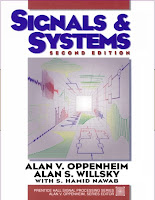 |
| Signals and Systems by Oppenheim |
Author Name:
Alan V. Oppenheim
Alan S. Willsky
Edition: Second Edition, (August 16, 1996)
Publisher: Prentice Hall
Pages: 116 pages
Size: 22.4 MB
ISBN-10: 0138147574
ISBN-13: 978-0138147570
Type: Soltuon Manual
Download Soltuon Manual here.
Download
Its in PDF format if you don't have Adobe Reader then please 1st download it.
Download Adobe Reader

The second edition of this well-known and highly regarded text can be used as the basis for a one- or two-semester undergraduate course in signals and linear systems theory and applications. Topics include basic signals and systems concepts, linear time-invariant (LTI) systems, Fourier representations of continuous-time and discrete-time signals, the CT and DT Fourier transforms, and time- and frequency-domain analysis methods. The author emphasizes applications of the theory through numerous examples in filtering, sampling, communications, and feedback. The parallel development of continuous-time and discrete-time frequency domain methods allows the reader to apply insights and intuition across the two domains. It also facilitates a deeper understanding of the material by bringing into focus the similarities and differences between the two domains. The text also includes introductory chapters on communication systems and control theory. This book assumes that you have a background in calculus as well as exposure to complex numbers and elementary differential equations. Because of its thoroughness and unhurried pace, this text is highly recommended for students and those interested in self-study.
Product Description
This comprehensive book of signals and systems develops continuous-time and discrete-time concepts/methods. Highly regarded for its intellectual quality, it provides a solid foundation and life-long reference for anyone studying the most important methods or modern signal and system analysis.
Table of Contents
(NOTE: Each chapter begins with an Introduction and concludes with a Summary.)
1. Signals and Systems.
Continuous-Time and Discrete-Time Signals. Transformations of the Independent Variable. Exponential and Sinusoidal Signals. The Unit Impulse and Unit Step Functions. Continuous-Time and Discrete-Time Systems. Basic System Properties.
2. Linear Time-Invariant Systems.
Discrete-Time LTI Systems: The Convolution Sum. Continuous-Time LTI Systems: The Convolution Integral. Properties of Linear Time-Invariant Systems. Causal LTI Systems Described by Differential and Difference Equations. Singularity Functions.
3. Fourier Series Representation of Periodic Signals.
A Historical Perspective. The Response of LTI Systems to Complex Exponentials. Fourier Series Representation of Continuous-Time Periodic Signals. Convergence of the Fourier Series. Properties of Continuous-Time Fourier Series. Fourier Series Representation of Discrete-Time Periodic Signals. Properties of Discrete-Time Fourier Series. Fourier Series and LTI Systems. Filtering. Examples of Continuous-Time Filters Described by Differential Equations. Examples of Discrete-Time Filters Described by Difference Equations.
4. The Continuous-Time Fourier Transform.
Representation of Aperiodic Signals: The Continuous-Time Fourier Transform. The Fourier Transform for Periodic Signals. Properties of the Continuous-Time Fourier Transform. The Convolution Property. The Multiplication Property. Tables of Fourier Properties and Basic Fourier Transform Pairs. Systems Characterized by Linear Constant-Coefficient Differential Equations.
5. The Discrete-Time Fourier Transform.
Representation of Aperiodic Signals: The Discrete-Time Fourier Transform. The Fourier Transform for Periodic Signals. Properties of the Discrete-Time Fourier Transform. The Convolution Property. The Multiplication Property. Tables of Fourier Transform Properties and Basic Fourier Transform Pairs. Duality. Systems Characterized by Linear Constant-Coefficient Difference Equations.
6. Time- and Frequency Characterization of Signals and Systems.
The Magnitude-Phase Representation of the Fourier Transform. The Magnitude-Phase Representation of the Frequency Response of LTI Systems. Time-Domain Properties of Ideal Frequency-Selective Filters. Time- Domain and Frequency-Domain Aspects of Nonideal Filters. First-Order and Second-Order Continuous-Time Systems. First-Order and Second-Order Discrete-Time Systems. Examples of Time- and Frequency-Domain Analysis of Systems.
7. Sampling.
Representation of a Continuous-Time Signal by Its Samples: The Sampling Theorem. Reconstruction of a Signal from Its Samples Using Interpolation. The Effect of Under sampling: Aliasing. Discrete-Time Processing of Continuous-Time Signals. Sampling of Discrete-Time Signals.
8. Communication Systems.
Complex Exponential and Sinusoidal Amplitude Modulation. Demodulation for Sinusoidal AM. Frequency-Division Multiplexing. Single-Sideband Sinusoidal Amplitude Modulation. Amplitude Modulation with a Pulse-Train Carrier. Pulse-Amplitude Modulation. Sinusoidal Frequency Modulation. Discrete-Time Modulation.
9. The Laplace Transform.
The Laplace Transform. The Region of Convergence for Laplace Transforms. The Inverse Laplace Transform. Geometric Evaluation of the Fourier Transform from the Pole-Zero Plot. Properties of the Laplace Transform. Some Laplace Transform Pairs. Analysis and Characterization of LTI Systems Using the Laplace Transform. System Function Algebra and Block Diagram Representations. The Unilateral Laplace Transform.
10. The Z-Transform.
The z-Transform. The Region of Convergence for the z-Transform. The Inverse z-Transform. Geometric Evaluation of the Fourier Transform from the Pole-Zero Plot. Properties of the z-Transform. Some Common z-Transform Pairs. Analysis and Characterization of LTI Systems Using z-Transforms. System Function Algebra and Block Diagram Representations. The Unilateral z-Transforms.
11. Linear Feedback Systems.
Linear Feedback Systems. Some Applications and Consequences of Feedback. Root-Locus Analysis of Linear Feedback Systems. The Nyquist Stability Criterion. Gain and Phase Margins.
Appendix: Partial-Fraction Expansion.
Bibliography.
Answers.
Index.






11 comments:
tq very much....
welcome dear...
Thanks a lot sir...
thank you !!!!!!!!!!
thanx a lot
thankx
for latest news visit
http://www.waqarsanpost.com/
Thankx
for latest news visit
waqarsanpost.com
Big Thanks :)
tq
Thanks a million :)
THANK YOU. VERY MUCH.
IT IS A "sOLUTION MANUAL" OF " SIGNALS & SYSTEMS" 2ND ED BY OPPENHEIM & WILSKY & HAMID.
I WAS LOOKING FOR IT ALL OVER NET. BUT FINALLY FOUND IT.
THANKS AGAIN.
Post a Comment